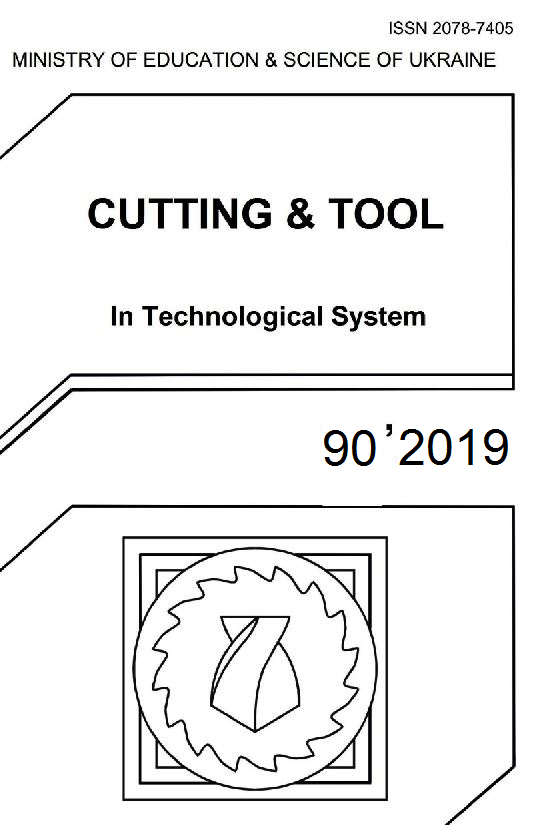MODELLING AND EXPERIMENTAL RESEARCH OF THE HEAT TRANSFER PROCESSES WHILE GRINDING WORKPIECES WITH PLASMA COATINGS
DOI:
https://doi.org/10.20998/2078-7405.2019.90.11Keywords:
temperature field, modelling, heat transfer, grinding, plasma coatings, energy distribution.Abstract
In the process of grinding, high values of thermal energy are generated due to the friction and stresses that occur when an abrasive grain removes the material of the surface layer. The major part of the produced energy flows into the workpiece that may have a negative impact on serviceability of the processed tool. Therefore productivity, quality and cost of the technological process of plasma coatings grinding depends on distribution of thermal energy, since an excessive increase of temperature within the contact zone between the grinding wheel and the workpiece causes surface and structural defects generation and propagation. Results of modelling of the temperature thermal field of plasma coatings during the grinding process are considered in the presented research. The obtained experimental data confirms estimated results on temperatures produced while the workpieces are being processed. Experimental testings are carried out for different conditions of dry and lubricated friction to define maximum values of temperatures for grinding regimes with the use of the cutting fluid. Analysis of the temperature field profile is required to obtain information about the heat energy distribution within a grinding zone, occurring heat transfer processes and energy fraction transported to the workpiece with a coating layer. This data is especially important in order to reduce grinding defects such as grinding burns and cracks, structural changes of plasma coating material and other intrinsic defects propagation as they tend to become centers of the possible crack formation. Another common type of defects, that makes it inappropriate to use a workpiece after being processed, is debonding of a coating layer from a substrate. In order to avoid the destruction of adhesive contacts between the coating layer and the substrate and to provide the required quality of the processed surface, modelling of temperature field and heat transfer distribution is necessary while setting optimal conditions for grinding plasma coatings.References
Blok H.A. Theoretical study of temperature rise at surfaces of actual contact under oiliness lubricating conditions / H.A. Blok // Proceedings of the Institution of Mechanical Engineers − London, 1937. – Vol. 2. − pp. 222-235.
Jaeger J.C. Moving sources of heat and temperature at sliding contacts / J.C. Jaeger // Proceedings: Royal Society – New South Wales, 1942. – Is. 76. – pp. 203-224.
Lavine A.S. An exact solution for surface temperature in down grinding / A.S. Lavine // International Journal of Heat and Mass Transfer, 2000. – Vol. 43. − pp. 4447-4456.
Landman U. Molecular dynamics simulations of adhesive contact formation and friction/U.Landman, W.D. Luedtke, E.M. Ringer // Fundamentals of Friction: Macroscopic and Microscopic Processes – Springer, Dordrecht, 1992. – pp. 463-510.
Rigney D.A. Plastic deformation and sliding friction of metals / D.A. Rigney, J.P. Hirth // Wear, 1979. – Vol. 53, Is.2. – pp. 345-370.
Zhang L. New heat flux model in surface grinding / L. Zhang, P.Q. Ge et al. // Materials Science Forum, 2004. – Vols. 471-472. − pp. 298-301.
Deivanathan R. Theoretical analysis of thermal profile and heat transfer in grinding / R. Deivanathan, L. Vijayaraghavan // International Journal of Mechanical and Materials Engineering (IJMME), 2013. − Vol. 8, No. 1. − pp. 21-31.
Deng Z.H. Critical Grinding Condition Model for Predicting Grinding Induced Lateral Cracks in Nanostructured Ceramic Coatings / Z.H. Deng, Q.Y. Jin, B. Zhang // Key Engineering Materials, 2004. − Vols. 259-260. − pp. 273-277.
González-Santander J. Maximum Temperature in Dry Surface Grinding for High Peclet Number and Arbitrary Heat Flux Profile / J.L. González-Santander // Mathematical Problems in Engineering, 2016. − Vol. 2016. − p. 9.
Usov A.V. Issledovanie termomehanicheskih yavleniy pri shlifovanii materialov i splavov, sklonnyih k treschinoobrazovaniyu / A.V. Usov, L.A. Vorobeva, S.G. Smirnyiy // Vostochno-Evropeyskiy zhurnal peredovyih tehnologiy, 2/7 (74), 2015. – c. 48-56.
Brinksmeier E. Advances in modelling and simulation of grinding processes / E. Brinksmeier, J.C. Aurich et al. // CIRP Annals - Manufacturing Technology, 2006. − Vol. 55, issue 2. − pp. 667-696.
Shirokov A.V. Povyishenie effektivnosti shlifovaniya zagotovok na osnove imitatsionnogo modelirovaniya protsessa formirovaniya sherohovatosti poverhnosti: dis. kand. tehn. nauk / A.V. Shirokov. – Samara, 2012. – 171 s.
Solovev V.A. Teoriya otslaivaniya plenok i zaschitnyih pokryitiy / V.A.Solovev, V.N. Sachko, T.D. SHermergor // Poverhnost. Fizika, himiya, mehanika. − № 10, 1982. − s. 51-58.
Tonkonogiy V.M. Vrahuvannya vlastivostey kompozitsіynih poroshkіv na osnovі TіS, plakovanogo Ni(P), pri rozrobtsі SAPR TP / V.M. Tonkonogiy, A.S. Sіnkovskiy, O.V. Ribak // Suchasnі tehnologії v mashinobuduvannі. – Vip.12. – Harkіv: HTU «HPІ», 2017. –
s. 31 – 41.
Downloads
Published
Issue
Section
License
Copyright Notice
Authors who publish with this Collection agree to the following terms:
1. Authors retain copyright and grant the Collection right of first publication with the work simultaneously licensed under a Creative Commons Attribution License that allows others to share the work with an acknowledgement of the work's authorship and initial publication in this Collection.
2. Authors are able to enter into separate, additional contractual arrangements for the non-exclusive distribution of the Collection's published version of the work (e.g., post it to an institutional repository or publish it in a book), with an acknowledgement of its initial publication in this Collection.
3. Authors are permitted and encouraged to post their work online (e.g., in institutional repositories or on their website) prior to and during the submission process, as it can lead to productive exchanges, as well as earlier and greater citation of published work.

